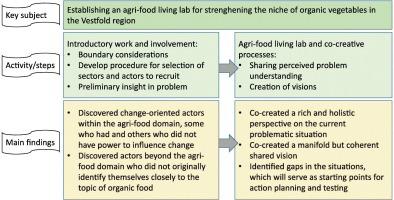Agricultural Systems ( IF 6.1 ) Pub Date : 2022-03-31 , DOI: 10.1016/j.agsy.2022.103403 Christine Hvitsand 1 , Ruth Kjærsti Raanaas 2 , Sigrid Gjøtterud 3 , Anna Marie Nicolaysen 1

|
CONTEXT
Agri-food systems face complex sustainability challenges, containing conflicting interests, goals, worldviews and fragmented knowledge and decision-making. There is a need for a better understanding of how to turn knowledge about sustainability into actions for change. The complexity of these challenges necessitates systemic, cross-sectorial, and multi-actor processes.
OBJECTIVE
The aim of this study was to strengthen agri-food systems associated with organic vegetables in the Vestfold region in Norway by involving actors through a living lab and to generate knowledge regarding the establishment phase of cross-cutting change initiatives. This included exploring how actors from within and beyond the agri-food domain could be selected and recruited and investigating what characterize their perceived understanding of the current situation regarding organic vegetables and their shared vision.
METHODS
We first drew the boundary of the living lab “system” in relation to improving the situation of organic vegetable agri-food systems. We explored potential participants by developing and applying a procedure for discovering sectors and actors that could contribute to overcome development obstacles. We then used the snowball sampling method and interviewed 48 actors, identifying 80 potential participants. Among these, 30 actors participated in a workshop in which we facilitated co-creative processes for creating a common problem understanding and a shared vision.
RESULTS AND CONCLUSIONS
The procedure helped identify change-oriented actors within the agri-food domain. Actors represented small-scale entities who had power to influence their own business, as well as individuals within large-scale entities with limited power to influence change in own organizations. We also discovered actors beyond the agri-food domain who did not originally identify themselves closely with the topic of organic food, such as actors from waste management, education, regional, business, and tourism development, and health and welfare. The diversity of actors contributed to a rich and holistic perspective on the current situation for agriculture and food. They co-created a manifold, but coherent, shared vision, portraying a more collaborative orientation in localized agri-food systems. The gaps between current and future desired situations clearly served as a starting point for action planning and testing.
SIGNIFICANCE
The study shows crucial steps in establishing an agri-food living lab, including introductory work of bounding the system, selecting actors, and conducting co-creative processes. The study developed and applied a procedure for discovering actors within and beyond the agri-food domain who could contribute to overcoming development obstacles. This procedure can be adjusted and utilized in other settings.
中文翻译:

为可持续发展转变建立农业食品生活实验室:从加强挪威 Vestfold 地区有机蔬菜生态位案例的方法论见解
语境
农业食品系统面临着复杂的可持续性挑战,包括相互冲突的利益、目标、世界观以及分散的知识和决策。需要更好地理解如何将可持续性知识转化为变革行动。这些挑战的复杂性需要系统的、跨部门的和多参与者的过程。
客观的
本研究的目的是通过一个活生生的实验室让参与者参与进来,加强挪威 Vestfold 地区与有机蔬菜相关的农业食品系统,并就跨领域变革倡议的建立阶段产生知识。这包括探索如何选择和招募农业食品领域内外的参与者,并调查他们对有机蔬菜现状的感知理解及其共同愿景的特点。
方法
我们首先为改善有机蔬菜农业食品系统状况划定了生活实验室“系统”的边界。我们通过开发和应用程序来发现可能有助于克服发展障碍的部门和参与者,从而探索了潜在的参与者。然后,我们使用滚雪球抽样法采访了 48 名演员,确定了 80 名潜在参与者。其中,30 名参与者参加了一个研讨会,我们在其中促进了共同创造过程,以建立对共同问题的理解和共同愿景。
结果和结论
该程序有助于确定农业食品领域内以变革为导向的参与者。参与者代表有权影响自己业务的小型实体,以及大型实体中影响自身组织变革的权力有限的个人。我们还发现了农业食品领域之外的参与者,他们最初并不认同有机食品的主题,例如来自废物管理、教育、区域、商业和旅游发展以及健康和福利的参与者。参与者的多样性有助于对农业和粮食的当前状况提供丰富而全面的视角。他们共同创造了一个多方面但连贯的共同愿景,描绘了本地化农业食品系统中更具协作性的方向。
意义
该研究展示了建立农业食品生活实验室的关键步骤,包括界定系统、选择参与者和进行共同创造过程的介绍性工作。该研究开发并应用了一个程序,用于发现农业食品领域内外的参与者,这些参与者可能有助于克服发展障碍。可以在其他设置中调整和使用此过程。











































 京公网安备 11010802027423号
京公网安备 11010802027423号